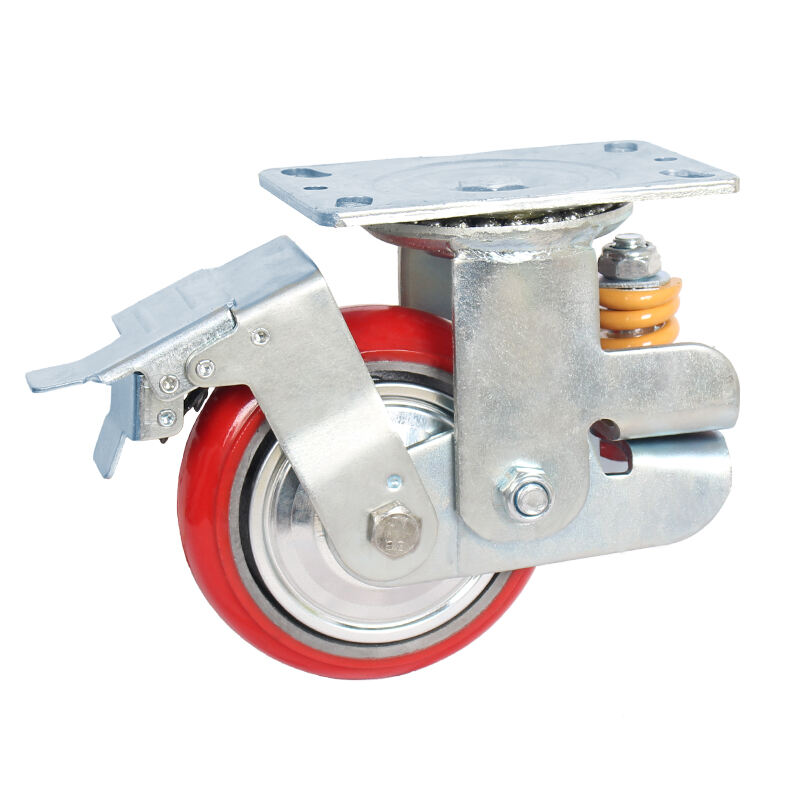産業用キャスター選定における重要な考慮点
選択する 重荷重用キャスターホイール 産業用途において最適な性能と長寿命を確保するために極めて重要です。これらの特殊ホイールは、物流機器の基盤として機能し、倉庫、製造工場、物流作業において不可欠となっています。選定に影響を与える主要な要因を理解することは、効率的な作業と高コストな停止時間の差を生む可能性があります。
産業用環境では、激しい使用に耐えながら機能性を維持できるキャスターホイールが求められます。積載能力から環境条件まで、適切な選定を行うためには複数の要素を慎重に検討する必要があります。選定プロセスを導く重要なポイントについて見ていきましょう。
荷重能力と重量分布
最大荷重評価
頑丈なキャスターホイールを選定する際、最初に最も重要となるのが荷重能力です。各キャスターには、安全に支えることのできる最大荷重を示す特定の耐荷重値が設定されています。移動対象の機器や材料の静的重量だけでなく、移動中に発生する動的負荷も考慮して正確に計算することが不可欠です。
業界の専門家は、実際の必要量よりも少なくとも25%高い耐荷重能力を持つキャスターホイールを選ぶことを推奨しています。この安全マージンにより、不均一な重量分布や突然の衝撃、その他の運用中に発生する予期しないストレス要因に対応できます。
重量分布パターン
複数のキャスターホイールにどのように重量が分配されるかを理解することは、適切な選定において極めて重要です。一般的な4輪構成では、荷重が常にすべてのホイールに均等に分配されるわけではありません。凹凸のある路面、加速、旋回などの要因により、特定のホイールにより大きな負担がかかるような重量の偏りが生じることがあります。
最適な性能を確保するためには、静的状態および動的状態における荷重の分配方法を検討してください。この分析により、追加のキャスターが必要かどうか、または特定の用途に最も適したホイール構成が異なるものであるかどうかを判断できます。
環境条件とホイール材質
表面互換性
施設内の床や表面の種類は、頑丈なキャスターホイールを選定する上で重要な役割を果たします。素材によって、床保護性、騒音低減性、転がり抵抗のレベルが異なります。例えば、ポリウレタンホイールは滑らかなコンクリート床に適しており、優れた床保護性と静かな作動を実現しますが、鋼製ホイールは凹凸のあるまたは損傷した表面に適している場合があります。
ホイールが異なる表面、段差、またはゴミの上を通過する必要があるかどうかを検討してください。ホイール素材はこれらの変化に対応でき、安定性を維持しつつ、ホイール自体と床への損傷を防ぐ必要があります。
温度および化学物質への暴露
産業環境では、極端な温度や化学物質への暴露など、キャスターホイールが過酷な条件にさらされることがよくあります。高温環境では、柔らかくなったり劣化したりしない特殊なホイール素材が必要となる場合があり、化学物質にさらされる場所では、腐食や化学的損傷に耐性を持つホイールが必要です。
このような環境で耐荷重キャスターホイールを選定する際は、メーカーの仕様書に記載された温度範囲および化学薬品耐性を注意深く確認してください。これにより、長期的な性能を確保し、ホイールの早期損傷を防ぐことができます。
移動要件と機動性
転がり抵抗の要因
動きを開始し、維持するために必要な力は、ホイールの転がり抵抗と直接関係しています。硬質のホイールは一般的に転がり抵抗が低いですが、より大きな音を発生させたり、床の保護性能が低下する場合があります。一方、柔らかい材質のホイールは動き始めるのにやや大きな力を要する可能性がありますが、優れた衝撃吸収性と静かな作動を提供します。
ホイールの硬度を選定する際は、移動の頻度および通常移動する距離を考慮してください。頻繁な始動・停止を伴う用途では、転がり抵抗の低いホイールが有利である場合があります。一方、長距離の連続走行を伴う用途では、他の要因を優先すべきです。
旋回性能
スムーズかつ容易に方向転換できる能力は、多くの用途において極めて重要です。設計の優れた自在金具(スイベル機構)付きの頑丈なキャスターホイールを使用することで、機器の取り回しが大幅に向上し、作業者の疲労を軽減できます。旋回半径やベアリングの品質は、狭いスペースでの機器の操作性に直接影響します。
正確な位置決めや頻繁な方向転換を必要とする用途では、精密ベアリングと堅牢なスイベル機構を備えたキャスターの使用を検討してください。これらの特徴により、長期間にわたりスムーズな動作が保証され、メンテナンス頻度も低減されます。
メンテナンスと長寿命に関する考慮事項
ベアリング選定
頑丈なキャスターホイールに使用されるベアリングの種類と品質は、その性能および寿命に大きく影響します。ローラーベアリングや単純穴あき構造と比較して、精密ボールベアリングは優れた転がり性能と耐久性を提供します。ただし、汚染物質からの保護が必要となる場合があり、定期的なメンテナンスを要することがあります。
ベアリングの種類を選定する際は、施設のメンテナンス能力と要件を検討してください。密封型の高精度ベアリングは最小限のメンテナンスで長寿命を実現できるため、特定の用途に適している場合があります。
車輪の交換およびメンテナンスアクセス
メンテナンスへのアクセスが容易で、車輪交換手順がシンプルなキャスターは、ダウンタイムとメンテナンスコストを最小限に抑えることができます。素早い車輪交換やベアリングの潤滑ポイントに簡単にアクセスできるキャスター設計を選びましょう。一部のメーカーは、メンテナンス時間を大幅に短縮できる分割式車輪やクイックチェンジ機能を提供しています。
選定の際には、交換部品の入手可能性やメーカーのサポート体制も考慮に入れてください。しっかりとしたサポート体制を持つ製品ラインであれば、設備の耐用期間全体を通じて効率的に維持管理できます。
よく 聞かれる 質問
頑丈なキャスターホイールはどのくらいの頻度で点検すべきですか?
定期的な点検は少なくとも月に1回は行い、過酷な使用条件ではさらに頻繁に点検を行う必要があります。摩耗の兆候、ベアリングの遊び、およびスイベル機能の正常性を確認してください。使用頻度が高い環境では、最適な性能と安全性を確保するために週に1回の点検が必要となる場合があります。
コンクリート床に最適な車輪の硬度とは何ですか?
コンクリート床の場合、デュロメーター値が70Aから95Aの範囲にある車輪が、床の保護性と転がりやすさのバランスにおいて通常最も適しています。ただし、具体的な要件は荷重の重さや使用パターンによって異なる場合があります。
産業用キャスターの寿命を延ばすにはどうすればよいですか?
キャスターの寿命を最大限に延ばすためには、定期的な潤滑を実施し、車輪をゴミや異物から清潔に保ち、荷重の均等な分布を確保し、異常な摩耗が見られた場合は速やかに対処してください。製造元のメンテナンスガイドラインに従い、過積載を避けることで、耐用年数を大幅に延ばすことができます。
スイベルキャスターではなくリジッドキャスターを選ぶべき状況はいつですか?
剛性キャスターは直線移動が必要な場合や非常に重い荷物を取り扱う際に最適です。方向の安定性と機動性の両方を実現するために、スイベルキャスターと組み合わせて使用されることがよくあります。具体的な比率は、用途の要件や所望の操作特性によって異なります。

